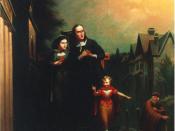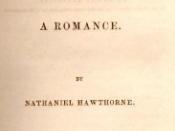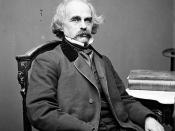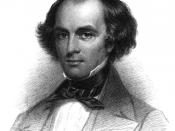Nathaniel Hawthorne's revolutionary novel, The Scarlet Letter, was written in the time where there were no exceptions; either one was holy and abided the law, or one was a sinner, condemned by all. In that time, life was centered around an impermeable Puritan society, in which secrets and innermost thoughts were to be kept inside the self. Hester Prynne, the protagonist of the story, tries to cope with the guilt that the town puts her through because of her sin. The other main characters of the story have to deal with their sins as well. Throughout the duration of the novel, the use of literary elements, such as motivation and conflict, form the foundation of the characters, as well as, the book itself, which creates a pillar of magnificence.
The motivation of the characters, the things that drive them, plays a key role in the development of the novel.
First of all, Hester is motivated to live a life of purity by the love for her daughter. Hester begins to notice that Pearl acts like a little imp, or "a demon offspring," so she makes sure to acts good and holy around Pearl. Hester Prynne also begins to raise Pearl through Christ, teaching her all she knows about Christianity, and taking her to Mass regularly. Next, Roger Chillingworth is motivated to track down and keep Reverend Dimmesdale in his grasp, by the fact that Dimmesdale seduced Hester to committing adultery. He does not, though, want revenge on Hester because she has already served her time by wearing the scarlet "ÃÂA' and being imprisoned. His actual sin is putting the matters into his own hands, when God should be the only one to judge people for their actions. In conclusion, the motivation of the characters is important to the novel because it explains their actions and feelings.
In addition, there are several main conflicts in the story that are essential to the development of the novel. To begin with, the town battles against Hester Pyrnne as a result of the sin she committed. The Puritan village is extremely against the sin of adultery, and therefore punishes Hester for her wrongdoing. Eventually, the town begins to accept her and she overcomes one of the harshest punishments, the scarlet letter. Also, Roger Chillingworth is in conflict with Reverend Dimmesdale from the first moment he knew he was Hester's partner. In the beginning, the conflict is hidden; Chillingworth does not say aloud that he knows Dimmesdale's secret and Dimmesdale is not sure that Chillingworth is evil until later on in the book. The conflict is resolved when Dimmesdale dies, and Chillingworth, not having any more power over him, dies as well. All in all, the numerous conflicts help build the foundation for the story by giving problems that must be resolved.
Hawthorne, by using literary elements such as these, created one of the most lasting and prominent masterpieces of all time. He used many literary elements, but the two of which allow the reader to see the problems within the book the best are conflict and motivation. The motivation leads to the development of the characters, and therefore the plot, which brings upon conflicts between them. The amount of time that Hawthorne worked on this novel can be seen by its importance to American literature and will be significant for years to come.





